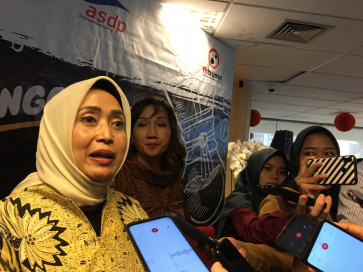Popular Reads
Top Results
Can't find what you're looking for?
View all search resultsPopular Reads
Top Results
Can't find what you're looking for?
View all search resultsAustralia is coming to Asia, speaking Asian languages
Australian Prime Minister Julia Gillard released the Australia in the Asian Century White Paper last Sunday
Change text size
Gift Premium Articles
to Anyone
A
ustralian Prime Minister Julia Gillard released the Australia in the Asian Century White Paper last Sunday. It is a policy paper that spells out various important objectives and strategies on how to achieve them, in relation to Australia’s role in Asia and its ever-developing economy.
It is important inasmuch as it states the government’s commitment to work in a coordinated way to find a place in this seemingly unstoppable regional economic growth. It is no mean feat, as it involves the country’s public and private sectors, all wanting a slice of the cake.
On the other hand, the fact that there needs to be such a paper in the first place speaks volumes of the general disconnectedness in Australia in terms of Asia.
Neither Australia nor any of the Asian countries have recently moved into the region, yet they seem to have just noticed each other.
Or have they? Discounting the early 20th century “discovery” of Asia by Australia, which led to White Australia Policy, Australia, or some sections of Australia, did discover Asia and had enough awareness of the importance of this region. However, the nature of this awareness evolved with time.
After World War II, Radio Australia’s broadcasts to the Asia Pacific region were to raise awareness of Australia and her proactive role in the region. Then, in the 1960s, visionary individuals like Herb Feith brought Indonesian studies into universities. Indonesian was subsequently taught, but in reality more for security and intelligence purposes rather than for the friendship-building as intended by Feith. The fear of the “yellow hordes” from the north was still strong.
Things began to look up in the late 1980s and early 1990s when organizations like the Australia Indonesia Institute and the Myer Foundation began to fund and promote innovative programs with the objective of creating mutual cultural understanding, prominent among them being the Institute’s Australia Indonesia Youth Exchange Program and the Myer Foundation’s funding of programs run by the Asia Pacific Journalist Centre, which sadly has been discontinued.
Asialink and the Asia Education Foundation with funding from the Myer Foundation have been running various cultural exchange programs with countries like Indonesia, India, China, Korea and Vietnam, and lately the Asia Education Foundation’s BRIDGE program has been very popular among teachers and students in schools in the
respective countries.
Worth mentioning also is ACICIS (Australian Consortium for In-country Indonesian Studies), run by 26 member universities, which provide opportunities and facilities for Australian students to study in Indonesian universities together with local students.
It is important to note that all these programs have been successfully run on relatively tight budgets. This really shows that Australia has commitment and competent human resources as well as a fair number of young people and adults who are interested in deepening their cultural knowledge of Asia. These are valuable assets not to be wasted.
It would seem bewilderingly short-sighted therefore, when the government stopped the funding for Asian studies across Australia in 2002. Then when it was resumed in 2008, the funds, to be released throughout a four-year span, were too small to achieve much. This year’s May budget shows that the funding was not even renewed.
In that context, the paragraph in chapter six of the paper sounds rather incongruous, “The capacity for Australians to build deeper ties with Asia will be hampered if there is not an increase in the proficiency of languages other than English.
Relying on the language capabilities of Asian-Australians for all of Australia’s relationships and engagement will not be adequate. Proficiency in more than one language is a basic skill of the 21st century.’’
Maybe Australians just cannot see the point of learning another language when they can get by with English much of the time. Unfortunately, as those who took the trouble of learning a second (or third) language will testify, those who didn’t, miss out on a whole world of knowledge and experience.
As long as policymakers belong to the latter group, this fact eludes them, Australia will continue to ignore, and waste, its own valuable resources of people who are competent in more than one language and more widely, culturally aware.
This general cultural unawareness became obvious in the general tone of the paper. It is heavy on the message that Australia needs to know Asia better, and light on Asia’s need to know Australia better, except as a resource-rich country in the fields of natural, financial, technology know-how and industry know-how. In fact, one cannot help seeing between the lines: “Now that you show promise to be economically significant, we’d like to make friends with you”.
The desire to learn from Asian countries, it seems, is not motivated by the belief that they have some good things to teach Australia, but that Australia needs to know how they operate to avoid “pitfalls” in doing business with them, or in dealing in other matters, such as regional security. To think that countries in Asia are unable to sense this patronizing attitude is downright careless.
The paper will most likely be generally well-received in Indonesia where people are more used to different types of behavior from its own diverse population, and do not take patronizing attitudes too seriously. And I believe that Indonesians of various sectors and groups are astute enough to perceive the great potential the proposals in the paper have.
However I certainly cannot speak for the whole of Asia. And for this endeavour to succeed, the paper must find a favorable spot in each of these countries.
The writer is a journalist and adjunct research associate at the School of Political and Social Inquiry at the faculty of arts, Monash University, Melbourne.










